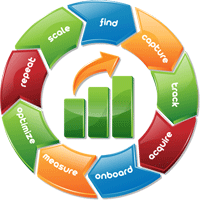Revenue Performance Management: Define Your Ideal Client and Find Them
As we've outlined, there are nine steps to effective Revenue Performance Management. Let's look closer at step one.
Step 1: Find leads or be found by prospects. Of course you must find or be found by prospects, but first you must define who those leads or prospects are so both sales and marketing can target them.

In the past, the focus was on sellers finding buyers, but thanks to the internet, today that's usually reversed. Company websites, online trade magazines, and social media provide instant access to all the information buyers need to qualify a vendor without ever making direct contact. And if they can find you online, they can do most of their research before you even know who they are.
So, a potential buyer may have little or no contact with an actual person from your company until they're nearly finished with their buyer's journey! To find or be found by future clients, we as sales and marketing professionals must adapt to this change.
Hopefully, you're already engaging in social media, blogging, email marketing, website upgrades, and search engine optimization (SEO) to get your brand out there. But are these efforts strategically targeted to the right audience? Without a strategy, each of these is just an uncoordinated, individual tactic.
Imagine that you coach a football team. Your strategy consists of patting your players on the back and telling them to go win the game and make you proud. You may win once or twice, but you'll probably loose most of the time. Your game plan is missing programmed plays, offensive and defensive schemes, and an analysis of the strengths and weaknesses of your opponent.
Most importantly, other than the very basic numbers on the scoreboard, you've collected no statistics that show how the team is performing, like yardage gained, passing attempts and completions, etc. In business, this would be like focusing on revenue to the exclusion of all other KPIs (key performance indicators).
Just as in football, a lack of strategy affects your business! To strategize, you need to know WHO your client is and HOW your message resonates. Understanding these important business parameters (and more) is critical to develop your digital strategy, and therefore your sales success.
I have worked with companies that do indeed understand their customer. However, when I ask an owner, for example, to define actual characteristics of that customer, I often find they just can't put it in words. Defining this "buyer persona" in detail is harder than it seems, in part because it requires you to focus on certain segments and set some limits on who you'll target.
Worse yet, sometimes the definition of an ideal client differs depending on whom you ask within the same organization! The business owner may have one idea, but sales has another, and marketing may have yet a third. Reaching consensus about your ideal client is critical! Sales and marketing need to agree on this so their work is complimentary and aims for the same goal. You may wonder if all this effort to define a persona is worth it, but if you don't know exactly who your clients are, how do you market to them?
I often advise sales and marketing teams to use the following questions with their favorite (i.e. best) customer in mind:
As you work through this list you may find that your teams are unsure or confused about the answers or how to prioritize what’s most important. You may not even agree on who your best customer is! That’s ok because this is a great opportunity to uncover assumptions and gaps. Sales and marketing will be better aligned after this process and that makes for tighter strategy and more wins.
The last step is coming up with a name for the persona(s) you develop. This gives you a simple shorthand when referring to them and makes them seem more real as you develop content and sales strategies. For example:
So, if you truly understand your buyers, (and you create buyer personas for them), you’ll truly understand the audience for your blogs, website, emails, etc. You can then be sure you’re providing these audiences with compelling content. Then, as they find you, you can begin the process of nurturing them.
Next up: the value of tracking leads and outreach. Meanwhile, please contact us to learn more about defining buyer personas and aligning your teams!
Editor’s note: This blog was originally published in 2014. It has been updated for accuracy and comprehensiveness.
Comments